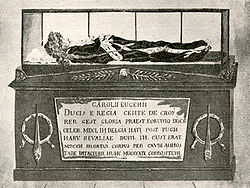
Charles Eugène de Croÿ
Encyclopedia

Field Marshal
Field Marshal is a military rank. Traditionally, it is the highest military rank in an army.-Etymology:The origin of the rank of field marshal dates to the early Middle Ages, originally meaning the keeper of the king's horses , from the time of the early Frankish kings.-Usage and hierarchical...
and duke
Duke
A duke or duchess is a member of the nobility, historically of highest rank below the monarch, and historically controlling a duchy...
from the House of Croÿ
House of Croÿ
The House of Croÿ is an international family of European mediatized nobility which held a seat in the Imperial Diet from 1486, and was elevated to the rank of Imperial Princes in 1594...
.
His father was Jacques Philippe de Croÿ-Roeulx (1614–1685), a descendant of Jean III of Croy-Roeulx, son of Antoine le Grand.
He married Wilhelmina Juliana van den Bergh, daughter of Hendrik van den Bergh
Hendrik van den Bergh (count)
Hendrik, count van den Bergh , lord of Stevensweert, was a Dutch soldier in Spanish service during the Eighty Years' War and stadhouder of Spanish Upper Guelders.-Life:...
and 13 year older than himself. They had no children.
He participated in the 1676 Battle of Lund
Battle of Lund
The Battle of Lund was fought on December 4, 1676 in an area north of the city of Lund in Scania in southern Sweden, between the invading Danish army and the army of Charles XI of Sweden. It was part of the Scanian War...
on the Dano-Norwegian side.
Later on he fought with success in the Austrian
Habsburg Monarchy
The Habsburg Monarchy covered the territories ruled by the junior Austrian branch of the House of Habsburg , and then by the successor House of Habsburg-Lorraine , between 1526 and 1867/1918. The Imperial capital was Vienna, except from 1583 to 1611, when it was moved to Prague...
army against the Ottoman Turks
Ottoman Turks
The Ottoman Turks were the Turkish-speaking population of the Ottoman Empire who formed the base of the state's military and ruling classes. Reliable information about the early history of Ottoman Turks is scarce, but they take their Turkish name, Osmanlı , from the house of Osman I The Ottoman...
and participated in both the liberation of Vienna in 1683 and the attack on Belgrade
Belgrade
Belgrade is the capital and largest city of Serbia. It is located at the confluence of the Sava and Danube rivers, where the Pannonian Plain meets the Balkans. According to official results of Census 2011, the city has a population of 1,639,121. It is one of the 15 largest cities in Europe...
in 1690. On October 18. 1692 he laid the foundation stone of the Petrovaradin Fortress
Petrovaradin fortress
Petrovaradin Fortress is a fortress in Novi Sad, Serbia. It is located in the province of Vojvodina, on the right bank of the Danube river. The cornerstone of the present-day southern part of the fortress was laid on October 18, 1692, by Charles Eugène de Croÿ...
and was promoted to Imperial
Holy Roman Empire
The Holy Roman Empire was a realm that existed from 962 to 1806 in Central Europe.It was ruled by the Holy Roman Emperor. Its character changed during the Middle Ages and the Early Modern period, when the power of the emperor gradually weakened in favour of the princes...
Field Marshal for his services.
In 1697 he started serving the Russian Tsar Peter the Great
Peter I of Russia
Peter the Great, Peter I or Pyotr Alexeyevich Romanov Dates indicated by the letters "O.S." are Old Style. All other dates in this article are New Style. ruled the Tsardom of Russia and later the Russian Empire from until his death, jointly ruling before 1696 with his half-brother, Ivan V...
and was Chief in Command for his forces for Livonia
Livonia
Livonia is a historic region along the eastern shores of the Baltic Sea. It was once the land of the Finnic Livonians inhabiting the principal ancient Livonian County Metsepole with its center at Turaida...
(Livonia at this time formed part of Sweden and the Polish Commonwealth). He was in command of the Russian forces in the Battle of Narva
Battle of Narva (1700)
The Battle of Narva on 19 November 1700 was an early battle in the Great Northern War. A Swedish relief army under Charles XII of Sweden defeated a Russian siege force three times its size. Before, Charles XII had forced Denmark-Norway to sign the Treaty of Travendal...
on 20 November 1700 when he surrendered and was taken prisoner by the Swedes
Swedish Empire
The Swedish Empire refers to the Kingdom of Sweden between 1561 and 1721 . During this time, Sweden was one of the great European powers. In Swedish, the period is called Stormaktstiden, literally meaning "the Great Power Era"...
.
He died in Reval (Tallinn)
Tallinn
Tallinn is the capital and largest city of Estonia. It occupies an area of with a population of 414,940. It is situated on the northern coast of the country, on the banks of the Gulf of Finland, south of Helsinki, east of Stockholm and west of Saint Petersburg. Tallinn's Old Town is in the list...
as a prisoner of war in 1702. On demand of his creditors, his body, which rested at St. Nicholas' Church
St. Nicholas' Church, Tallinn
St. Nicholas' Church is a medieval church in Tallinn, Estonia. It is dedicated to Saint Nicholas, the patron of the fishermen and sailors. Originally built in the 13th century, it was partially destroyed in Soviet Bombing of Tallinn in World War II...
, was not buried for more than 190 years, and, when mummified, was exhibited as a curiosity.

